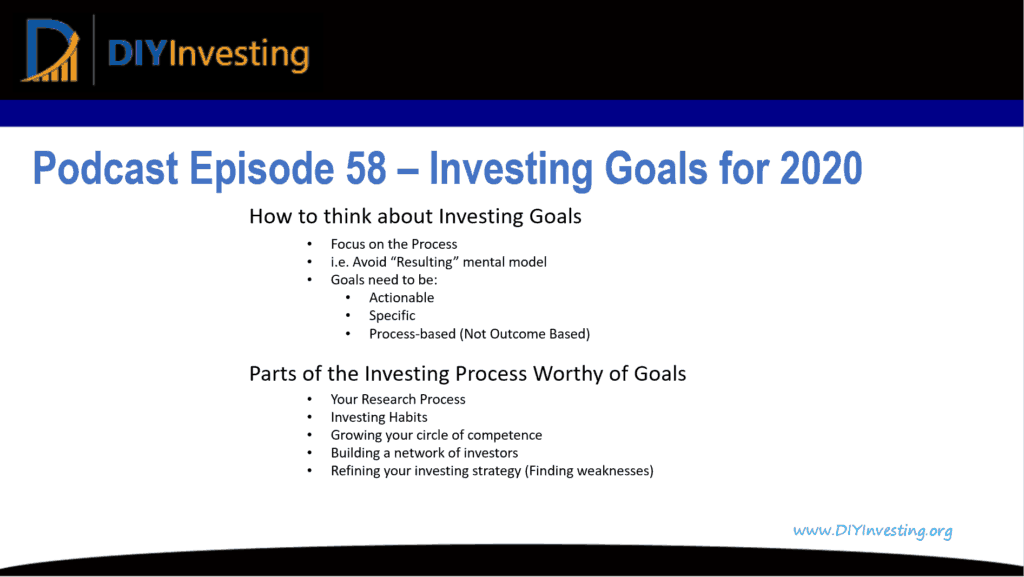Mental Models discussed in this podcast:
- Circle of Competence
- Habits
- Resulting (read: “Thinking in Bets” by Annie Duke)
- Focus on Process over Results
- Networking Effects
- Signal vs Noise
Please review and rate the podcast
If you enjoyed this podcast and found it helpful, please consider leaving me a rating and review. Your feedback helps me to improve the podcast and grow the show’s audience.
Follow me on Twitter and YouTube
Twitter Handle: @TreyHenninger
YouTube Channel: DIY Investing
Support the Podcast on Patreon
This is a podcast supported by listeners like you. If you’d like to support this podcast and help me to continue creating great investing content, please consider becoming a Patron at DIYInvesting.org/Patron.
You can find out more information by listening to episode 11 of this podcast.
Show Outline

How to think about investing goals
- The important thing to remember about goals is that you need to focus on what you can control. You don’t control investing outcomes, you can only control your investing process.
- Therefore, any goal that explicitly mentions a specific investing outcome is bound to result in disappointment and frustration. (Such as “My goal is to earn a 10% return this year.” Replace 10% with whatever number you like, it’s not a helpful goal.)
Parts of the Investment Process Worthy of Goals
- Your research process
- Investing Habits
- Growing your circle of competence
- Building a network of investors
- Refining your investing strategy (Finding weaknesses)
My personal investing goals for 2020:
- Identify one company worthy of investing 20% of my portfolio.
- Actually invest in that company.
- How might I do that?
- Filter through a lot of companies. Maybe I set a goal of reading one 10k a week. That allows me to read over 50 10k’s in the year. Perhaps after looking at 50 companies, I might find one worth investing money in.
- Focus on identifying high-quality companies. If a company is unlikely to be of high quality, it probably shouldn’t fit in my list of 50 companies to review in detail.
- Focus on cheap companies. If the company isn’t cheap, it’s unlikely to be a stock I invest in this year.
- Focus on companies with the ability to distribute a large amount of cash to shareholders. I tend to prefer capital-light businesses, so I should focus my time and effort there.
- Investing Habits: Identify and eliminate one bad investing habit that I’m currently doing, and implement one new investing habit that should have a positive outcome.
- In 2018, my focus was on removing investing noise from sources like CNBC.
- In 2020, I think my goal is to only check stock prices once a week.
- Grow your circle of competence:
- In 2020, I really want to better understand banks and the banking industry. Banks seem like fertile ground for new long-term investments especially when interest rates are low. So, I want to focus on building expertise as a bank investor.
- Building a network of investors:
- In 2020, I want to interview 12 different investors on my podcast. Each interview teaches me something new about investing and grows my network of investors to learn from and source ideas.
- In addition, in 2020 I want to grow my Twitter following to surpass 1,000 followers. I have found FinTwit (Financial Twitter) to be a huge boon in helping me learn more about investing. As I connect more with other investors on Twitter, I hope to become an even better investor.
- Refining my investing strategy (Finding my weaknesses)
- If I knew my investing weakness that I would discover today, it wouldn’t be a goal. So, I’ll simply plan to complete a post-mortem analysis on each of the companies that I sold in 2019 to see what I can learn from those investments.
- I wish I had already completed those post mortems, but I should have time to complete it in 2020.
Summary:
In summary, focus on improving your investing process. Only by focusing on what you can control and improve on, will you actually see long-term improvements in your investing results. Simply making a goal to improve investment results will not help you. You have to identify your weaknesses and eliminate them. Meanwhile, grow and build on your strengths. Over time, and executed on each year, you should become a much better investor.
